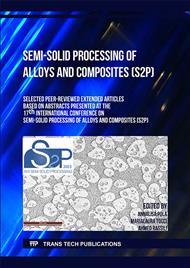p.1
p.7
p.15
p.21
p.27
p.33
p.39
p.47
Impact of Processing Conditions on the Fluidity and Consistency of GISS-Processed Semi-Solid Aluminum Alloys
Abstract:
GISS (Gas Induced Superheated Slurry) is one of the more popular processes for the production of commercial semi-solid castings. For the successful production of high-quality castings, it is necessary to understand the impact of processing parameters on the flow behavior of the semi-solid metal. This paper describes the results of laboratory studies to examine the effects of processing conditions on the development of semi-solid feed material during GISS processing for two aluminum casting alloys, ADC12 and A356. Two series of tests were performed. The first involved a simple pouring test along an inclined section of a v-channel, to determine if differences in flow behavior could be identified. The second series of trials examined the effect of processing temperature and time on the consistency and flow behavior of the aluminum alloys. Ladles of molten aluminum alloy were treated using the GISS process at different temperatures for between zero and 10 seconds. After the treatment, the alloy was allowed to further cool in the ladle into the semi-solid temperature range, at which time the flow behavior of was compared. Consistency more suited to semi-solid casting was obtained when the GISS treatment temperature was lower and treatment time longer.
Info:
Periodical:
Pages:
1-6
Citation:
Online since:
August 2023
Authors:
Keywords:
Price:
Сopyright:
© 2023 Trans Tech Publications Ltd. All Rights Reserved
Share:
Citation:



